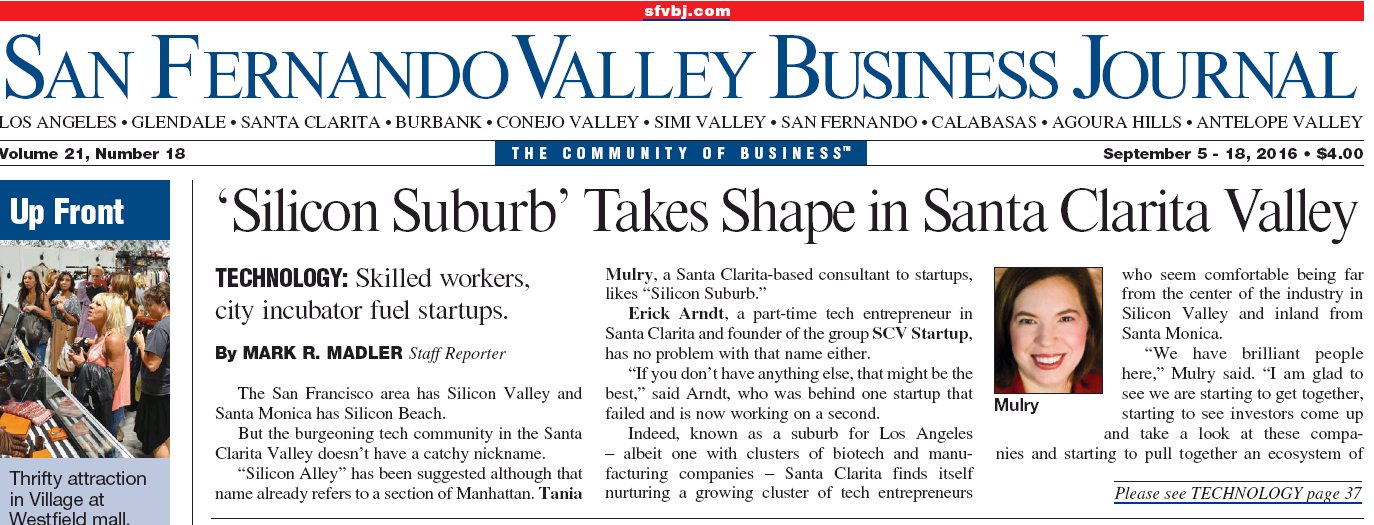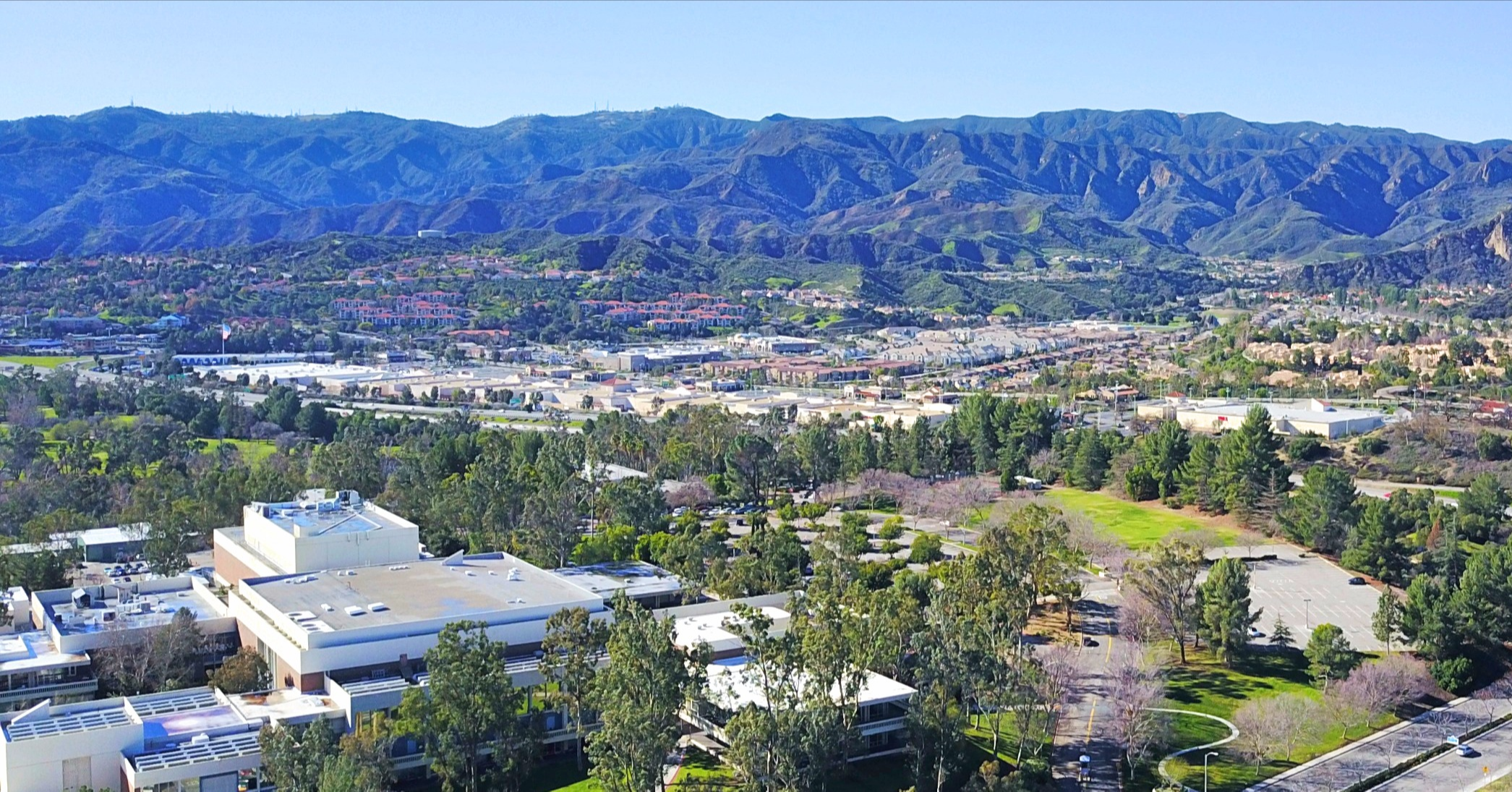
The San Francisco area has Silicon Valley and Santa Monica has Silicon Beach. But the burgeoning tech community in the Santa Clarita Valley doesn’t have a catchy nickname.
“Silicon Alley” has been suggested although that name already refers to a section of Manhattan. Tania Mulry, a Santa Clarita-based consultant to startups, likes “Silicon Suburb.”
Erick Arndt, a part-time tech entrepreneur in Santa Clarita and founder of the group SCV Startup, has no problem with that name either.
“If you don’t have anything else, that might be the best,” said Arndt, who was behind one startup that failed and is now working on a second.
Indeed, known as a suburb for Los Angeles – albeit one with clusters of biotech and manufacturing companies – Santa Clarita finds itself nurturing a growing cluster of tech entrepreneurs who seem comfortable being far from the center of the industry in Silicon Valley and inland from Santa Monica.
“We have brilliant people here,” Mulry said. “I am glad to see we are starting to get together, starting to see investors come up and take a look at these companies and starting to pull together an ecosystem of resources to support them.”
The startups located in Santa Clarita have yet to set the world on fire, although they have behind them some dedicated and passionate entrepreneurs. They include educational mobile game developer Nuhubit Software Studios; Kadenze, an educational platform to distribute college-level creative arts curricula online; 3D-Sensir, a designer and manufacturer of 3D camera systems; and PayForward, an online financial transaction platform.
Interaction within this small community has been limited but is expanding. For instance, Mulry met Ajay Kapur, co-founder of Kadenze, at a Startup Weekend last year, an event brought to the city by Arndt. Alex Bozman, founder of Nuhubit, originated a group that meets weekly at a Newhall coffee shop to discuss startup strategy.
Even with those strides, some in the community said much work remains as a disconnect exists among the entrepreneurs.
“To some degree people walk by each other,” said Bozman.
Holly Schroeder, chief executive of the Santa Clarita Valley Economic Development Corp., said that a big challenge is the city is not known as a location for tech companies outside of those already here.
“I think improving that awareness that there is a tech community here and there is a great workforce here and matched with a business friendly environment would be good for us in the long run,” Schroeder said.
The city’s economic development department, College of the Canyons and the Small Business Development Center have tried to provide different levels of support.
The city, for example, early last year opened the Santa Clarita Business Incubator in a former library building in the Old Town Newhall neighborhood. Nuhubit is among the companies using space there along with 3D-Sensir and Outlyer Technologies, a virtual reality startup that created Advrtas, a 360-degree advertising platform.
Elsewhere in the city, Kadenze and PayForward are located in the same building on Tourney Road, just off the 5 Freeway. Nearby on Magic Mountain Parkway is Brandwood Global, a startup that develops branded entertainment deal management software.
It’s all part of what Arndt described as a dynamic and constantly changing tech scene.
“That is what happens in a startup community,” he added. “New people come in, people leave, new startups form, they die, and from those deaths those guys go out and start a new one or they join an existing one.”
Cal Arts connection
A native of New York, Arndt has been in Santa Clarita for eight years. He started SCV Startup in 2013 after it became time-consuming to drive to Santa Monica for tech-related gatherings. He began to meet people in Santa Clarita who were doing the same thing, he said.
“We had talented developers and designers and good business heads but they did not know each other,” he explained.
Mulry, in addition to being a tech advisor, also operates her own marketing firm and is an adjunct professor at USC in mobile media and devices. The academic background made it easy to bond with Kadenze’s Kapur, who is an associate dean for research and development in digital arts and director in music technology at California Institute of the Arts, the creative school in Santa Clarita.
“At least 50 percent of the company is Cal Arts alumni,” Kapur said.
The background of some of the other Santa Clarita entrepreneurs is more technical than creative.
Bozman is a former aerospace software engineer and taught cello. Michael LaRue also worked in aerospace, including on the B-2 bomber and Global Hawk drone for Northrop Grumman Corp., before founding his startup Zejoop in 2012. Greg Campbell, chief executive at 3D-Sensir, worked at Spectrolab, the Boeing Co. subsidiary in Sylmar that makes solar panels for satellites and other spacecraft.
Bozman said that a handful of people come to his weekly morning coffee meetings. The Startup Weekend event last fall drew about 50 people who spent two days working on projects judged by Mulry, Kapur and a few others.
“There is a growing community and most of us hang out because we want to build something,” Kapur said.
Investor interest
Last month, the city sponsored a mixer at its incubator that attracted a crowd of between 25 and 30 people, said Denise Covert, an economic development associate. It was a good opportunity for people to meet others who are interested in the tech and startup community, she added.
“We are looking forward to seeing what new connections and what new synergies can be made from that event,” Covert said.
While social support has its merit, it takes more than that to make a vibrant tech scene. Investors, co-working space, a breakout successful company and additional business resources are necessary ingredients as well.
Arndt in particular would like to see a co-working space in Santa Clarita similar to what is found in Santa Monica. While the city’s incubator has its place, he personally believes it’s an outdated model that lacks excitement.
“If you go to co-working spaces in Santa Monica, you will feel the energy when you walk in,” he added.
Mulry thinks that the city’s tech scene needs more investors to pay attention to what is taking place. There has been some notice taken as investors were on the judging panel of last year’s Startup Weekend. Kadenze, for instance, was funded by angel investors.
“We see what is happening in other places,” Mulry said. “There is a lot of social activity, meetups, conferences and events that connect founders and funders and we need to see more of that.”
Copyright of San Fernando Valley Business Journal. Reprinted by permission. For more business info about San Fernando Valley and the surrounding areas, please go to http://sfvbj.com/
.png?width=1198&name=EDC_cmyk_orange-white%20horizontal.F%20(1).png)



